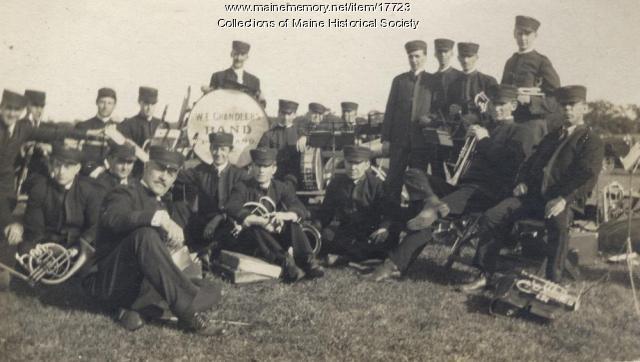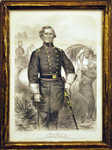Keywords: Associates
- Historical Items (1769)
- Tax Records (54)
- Architecture & Landscape (1861)
- Online Exhibits (121)
- Site Pages (155)
- My Maine Stories (23)
- Lesson Plans (25)
Online Exhibits
Your results include these online exhibits. You also can view all of the site's exhibits, view a timeline of selected events in Maine History, and learn how to create your own exhibit. See featured exhibits or create your own exhibit
Exhibit
Before the era of recorded music and radio, nearly every community had a band that played at parades and other civic events. Fire departments had bands, military units had bands, theaters had bands. Band music was everywhere.
Exhibit
Northern Threads: Civil War-era clothing
An exhibit vignette within "Northern Threads, Part 1," featuring American Civil War civilian and military clothing, 1860 to 1869.
Exhibit
History in Motion: The Era of the Electric Railways
Street railways, whether horse-drawn or electric, required the building of trestles and tracks. The new form of transportation aided industry, workers, vacationers, and other travelers.
Exhibit
Irish Immigrants in Nineteenth Century Maine
With the popularity of all things Irish in modern America, many people have forgotten the difficulties faced by nineteenth century Irish immigrants.
Exhibit
Christmas, a Christian holiday observed by many Mainers, has a very public, seasonal face that makes it visible to those of all beliefs.
Exhibit
Maine's first governor, William King, was arguably the most influential figure in Maine's achieving statehood in 1820. Although he served just one year as the Governor of Maine, he was instrumental in establishing the new state's constitution and setting up its governmental infrastructure.
Exhibit
Westbrook Seminary: Educating Women
Westbrook Seminary, built on Stevens Plain in 1831, was founded to educate young men and young women. Seminaries traditionally were a form of advanced secondary education. Westbrook Seminary served an important function in admitting women students, for whom education was less available in the early and mid nineteenth century.
Exhibit
J.A. Poor and the Portland-Montreal Connection
John A. Poor's determination in 1845 to bring rail service to Maine and to make Portland the winter port for Montreal, along with the steel foundry he started to build locomotives and many other products, helped boost the economy of Portland the state.
Exhibit
Northern Threads: Adaptive reuse
A themed vignette within "Northern Threads Part I," featuring up-cycled and reused historic fabrics.
Exhibit
Northern Threads: The rise and fall of the gigot sleeve
A themed exhibit vignette within "Northern Threads Part I," featuring the balloon-like gigot sleeve of the 1830s.
Exhibit
Informal family photos often include family pets -- but formal, studio portraits and paintings also often feature one person and one pet, in formal attire and pose.
Exhibit
Mainers began propagating fish to stock ponds and lakes in the mid 19th century. The state got into the business in the latter part of the century, first concentrating on Atlantic salmon, then moving into raising other species for stocking rivers, lakes, and ponds.
Exhibit
Practical Nursing in Waterville
The Maine School of Practical Nursing opened a facility in Waterville in 1957 and continued teaching practical nursing there until about 1980 when changes in the profession and in the state's educational structure led to its demise.
Exhibit
Rum, Riot, and Reform - Politics and Enforcement
"… were pictured as the party of immigrants and by association, alcohol. X Voters, Attention! Alfred, 1906 Collections of Maine Historical…"
Exhibit
Rum, Riot, and Reform - Neal Dow
"951, vol. 53 Elder Benjamin D. Peck, a close associate of Neal Dow in the temperance crusade, served as State Treasurer from 1857 to 1860."
Exhibit
Northern Threads: Mourning Fashions
A themed exhibit vignette within "Northern Threads Part I," featuring 18th and 19th century mourning jewelry and fashions.
Exhibit
The rocky coastline of Cape Elizabeth has sent many vessels to their watery graves.
Exhibit
A City Awakes: Arts and Artisans of Early 19th Century Portland
Portland's growth from 1786 to 1860 spawned a unique social and cultural environment and fostered artistic opportunity and creative expression in a broad range of the arts, which flowered with the increasing wealth and opportunity in the city.
Exhibit
Navy Firefighting School, Little Chebeague Island
Little Chebeague Island in Casco Bay was home to recreational facilities and a firefighting school for WWII sailors. The school was part of a Navy effort to have non-firefighting personnel knowledgeable in dealing with shipboard fires.
Exhibit
This collection of images portrays many buildings in Sanford and Springvale. The images were taken around the turn of the twentieth century.
Exhibit
A Town Is Born: South Bristol, 1915
After being part of the town of Bristol for nearly 150 years, residents of South Bristol determined that their interests would be better served by becoming a separate town and they broke away from the large community of Bristol.
Exhibit
Success at riding a bike mirrored success in life. Bicycling could bring families together. Bicycling was good for one's health. Bicycling was fun. Bicycles could go fast. Such were some of the arguments made to induce many thousands of people around Maine and the nation to take up the new pastime at the end of the nineteenth century.
Exhibit
Scarborough: They Answered the Call
Scarborough met every quota set by the state for supplying Civil War soldiers for Union regiments. Some of those who responded became prominent citizens of the town.
Exhibit
Fallen Heroes: Maine's Jewish Sailors and Soldiers
Thirty-four young Jewish men from Maine died in the service of their country in the two World Wars. This project, including a Maine Memory Network exhibit, is meant to say a little something about some of them. More than just names on a public memorial marker or grave stone, these men were getting started in adult life. They had newly acquired high school and college diplomas, they had friends, families and communities who loved and valued them, and felt the losses of their deaths.
























